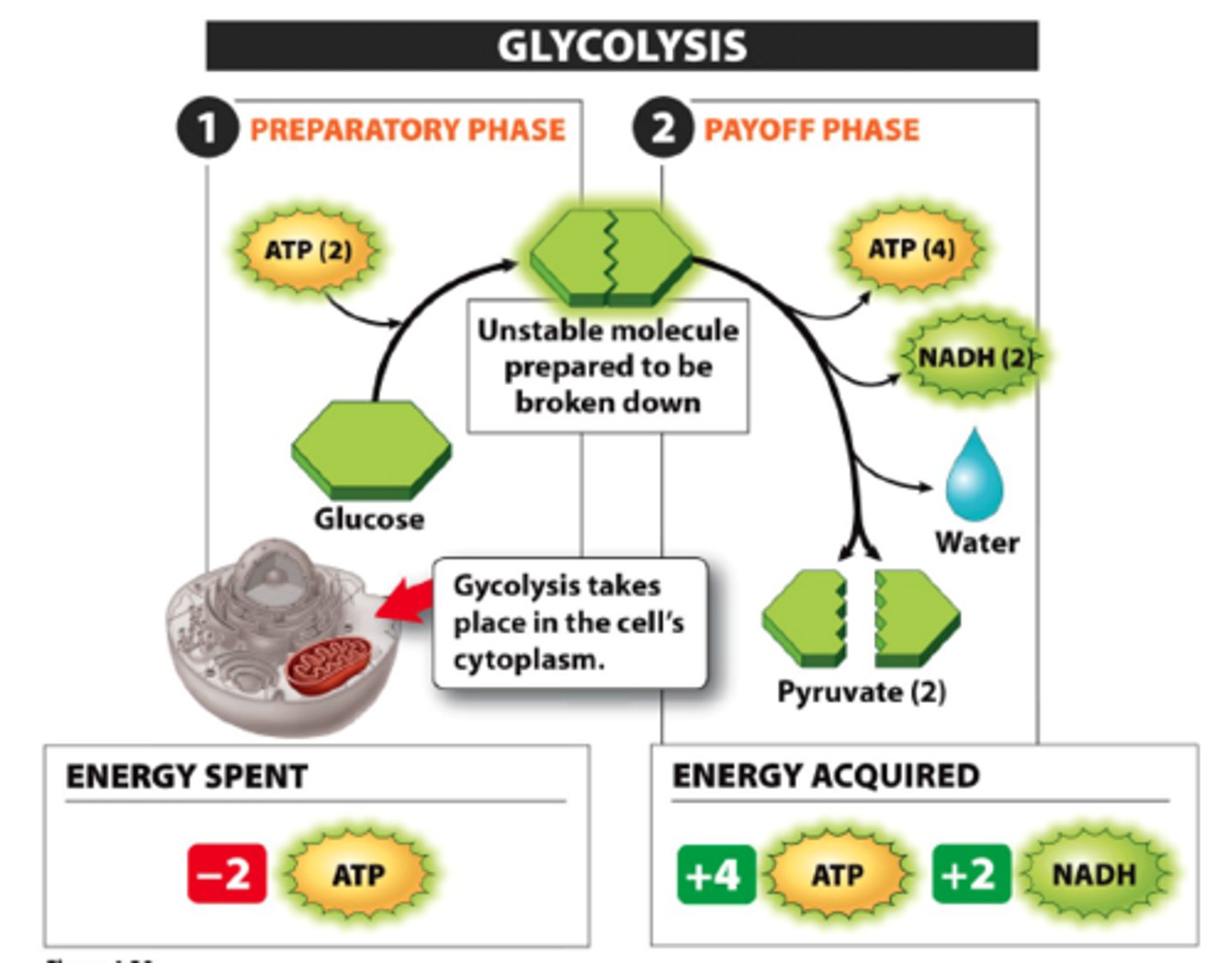Life on Earth 8
1/64
There's no tags or description
Looks like no tags are added yet.
Name | Mastery | Learn | Test | Matching | Spaced |
|---|
No study sessions yet.
65 Terms
Thylakoid
A flattened membrane sac inside the chloroplast, used to convert light energy into chemical energy.
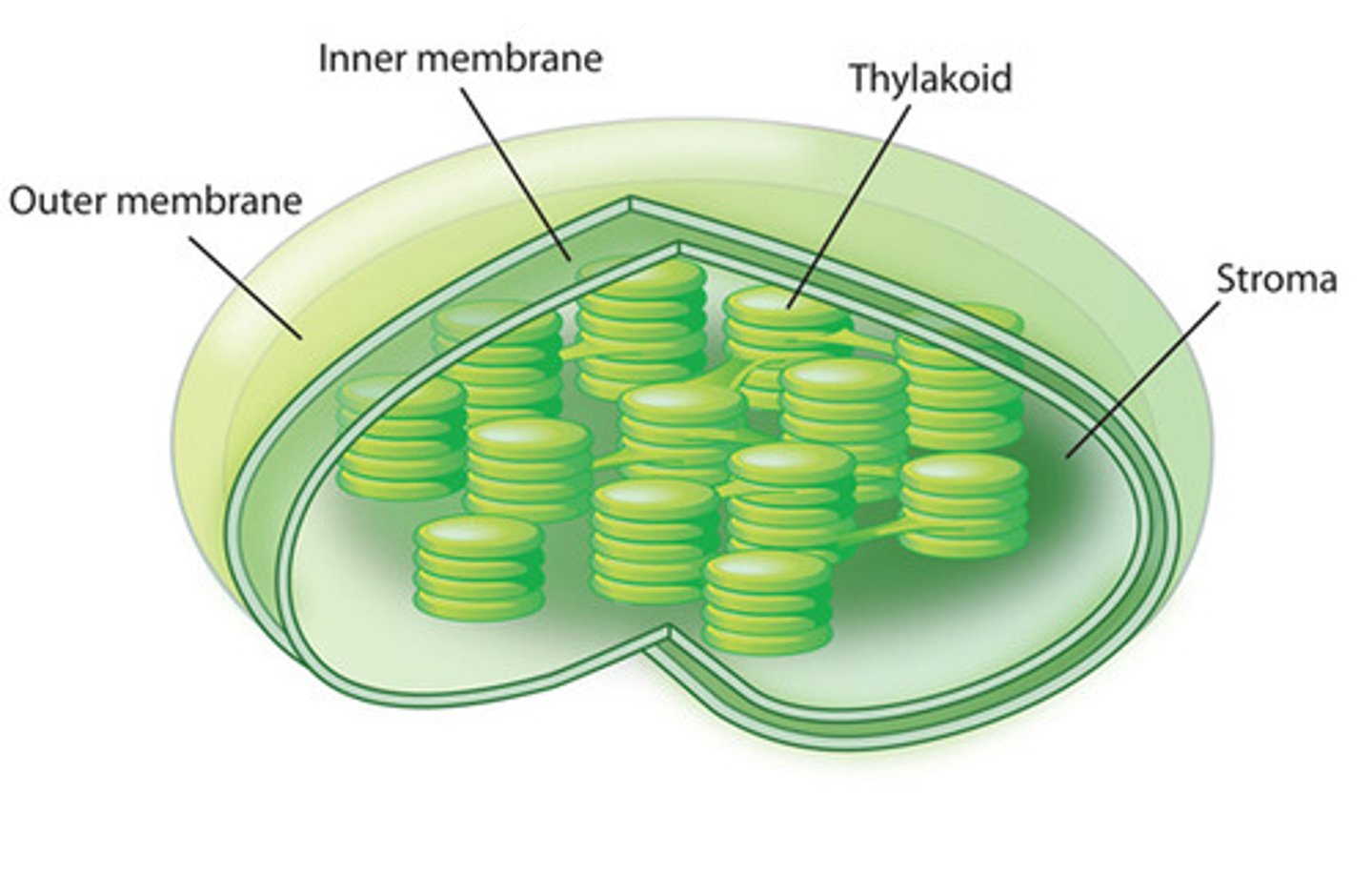
photosystem I
One of two light-harvesting units of a chloroplast's thylakoid membrane; it uses the P700 reaction-center chlorophyll.
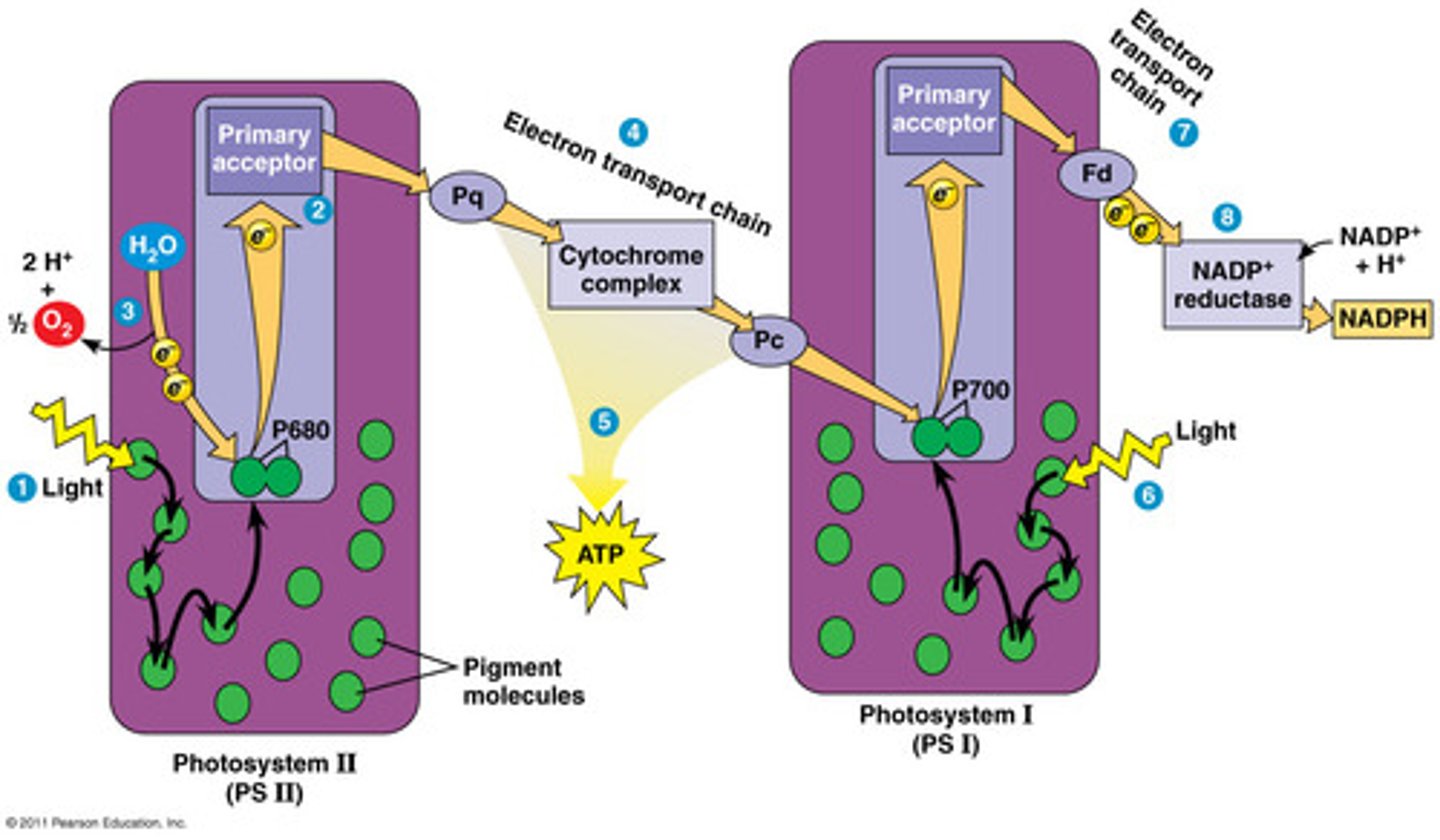
antenna pigments
what are all other pigments in photosystem that capture photon energy and funnel it to reaction center
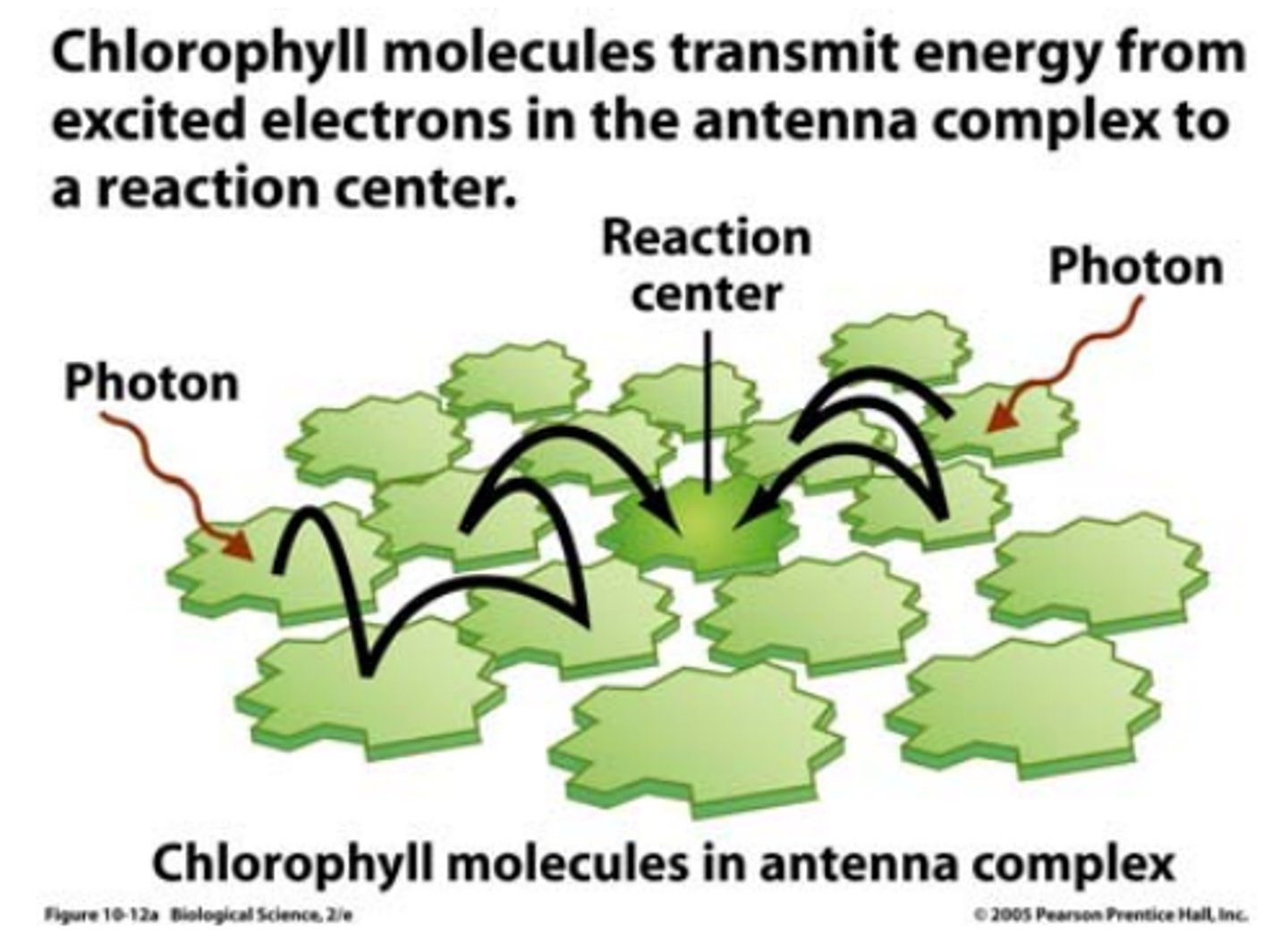
The cytochrome complex
an enzyme composed of two protein complexes, transfers the electrons from the carrier molecule plastoquinone (Pq) to the protein plastocyanin (Pc), thus enabling both the transfer of protons across the thylakoid membrane and the transfer of electrons from PSII to PSI.
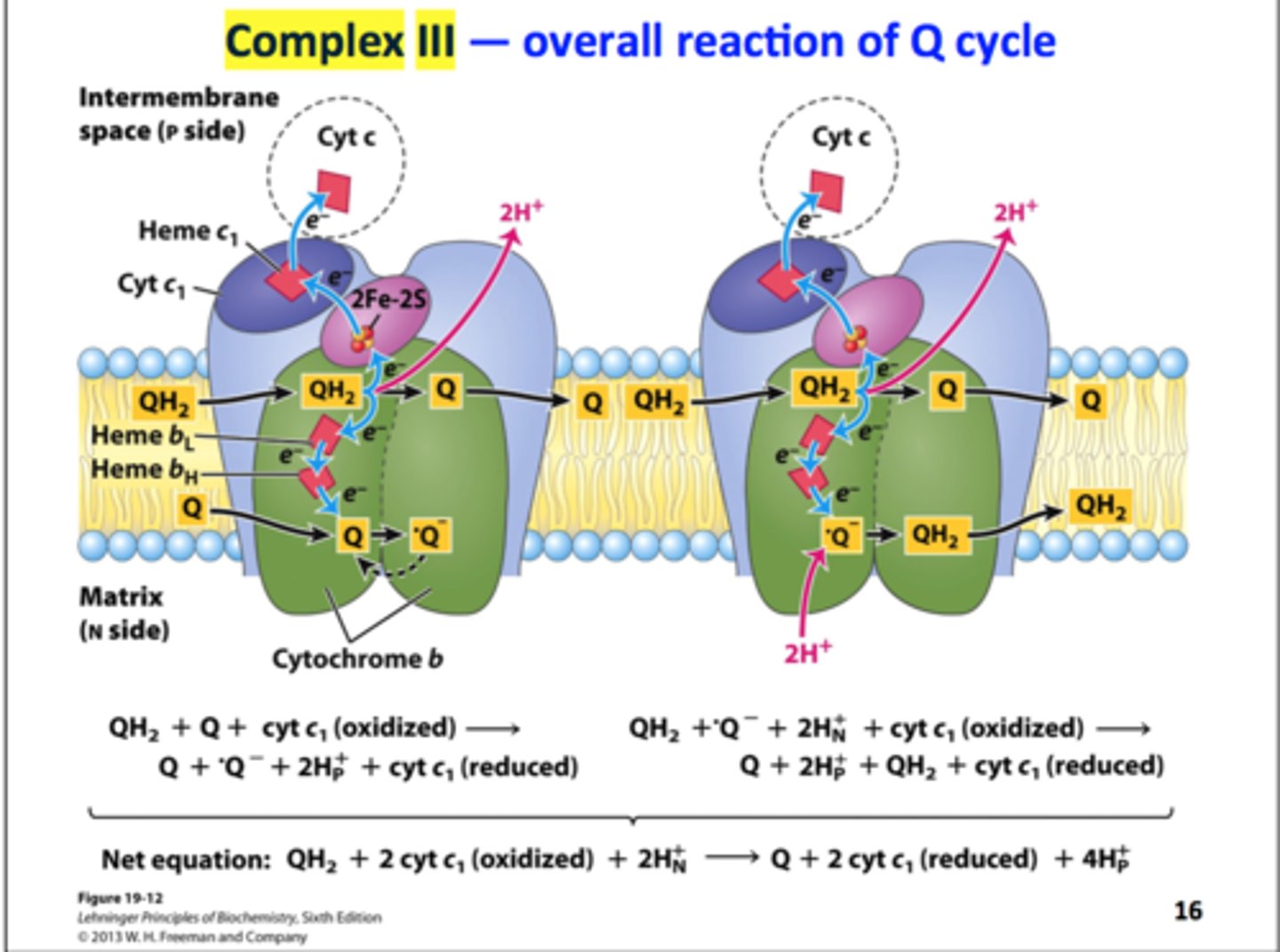
Carbon Reduction
Energy from ATP and NADPH are used to convert the PGAmolecules to G3P (glyceraldehyde-3-phosphate).
Two molecules of G3P lead to formation of a glucose or fructose
photoautotrophs
Organisms that use light as a source of energy to synthesize organic substances. ("self-feeders using light")
Therefore, photosynthesis powers
99% of the Earth's ecosystems
thermoregulation
Process of maintaining an internal temperature within a tolerable range.
mesophyll
In plants, photosynthesis generally takes place in leaves, which consist of several layers of cells. The process of photosynthesis occurs in a middle layer called the
chloroplast
In all autotrophic eukaryotes, photosynthesis takes place inside an organelle called a
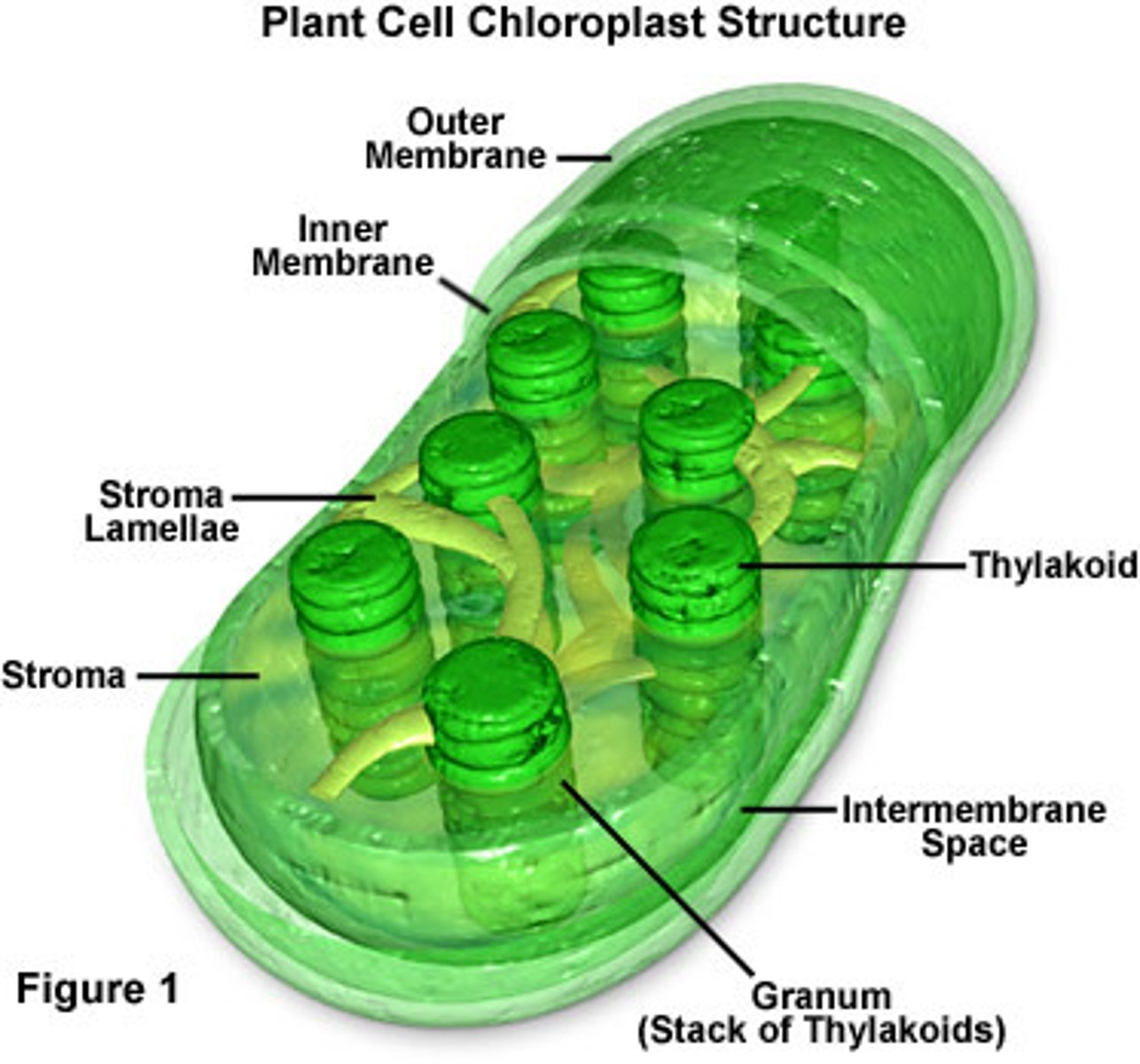
granum
stack of thylakoids
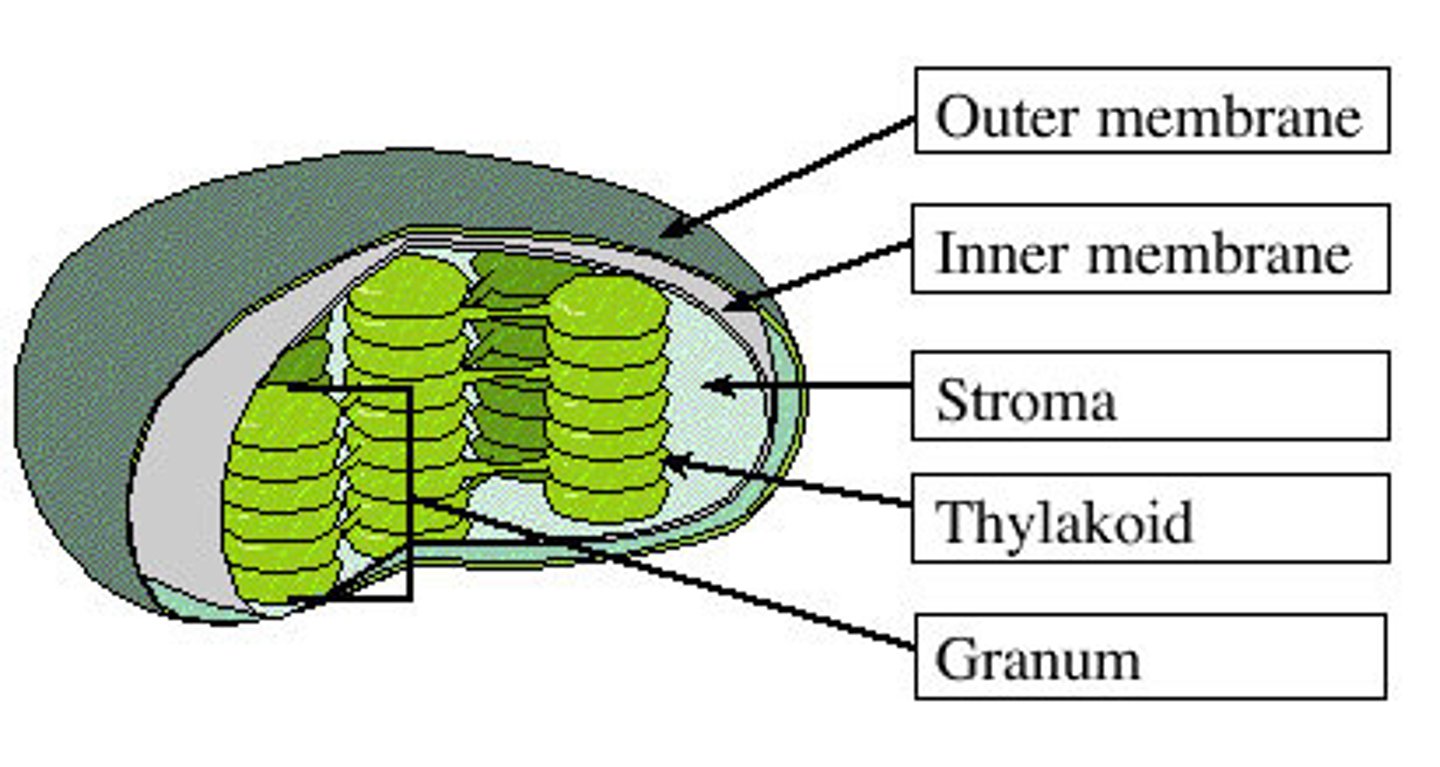
stroma
fluid portion of the chloroplast; outside of the thylakoids. (Not to be confused with stoma)
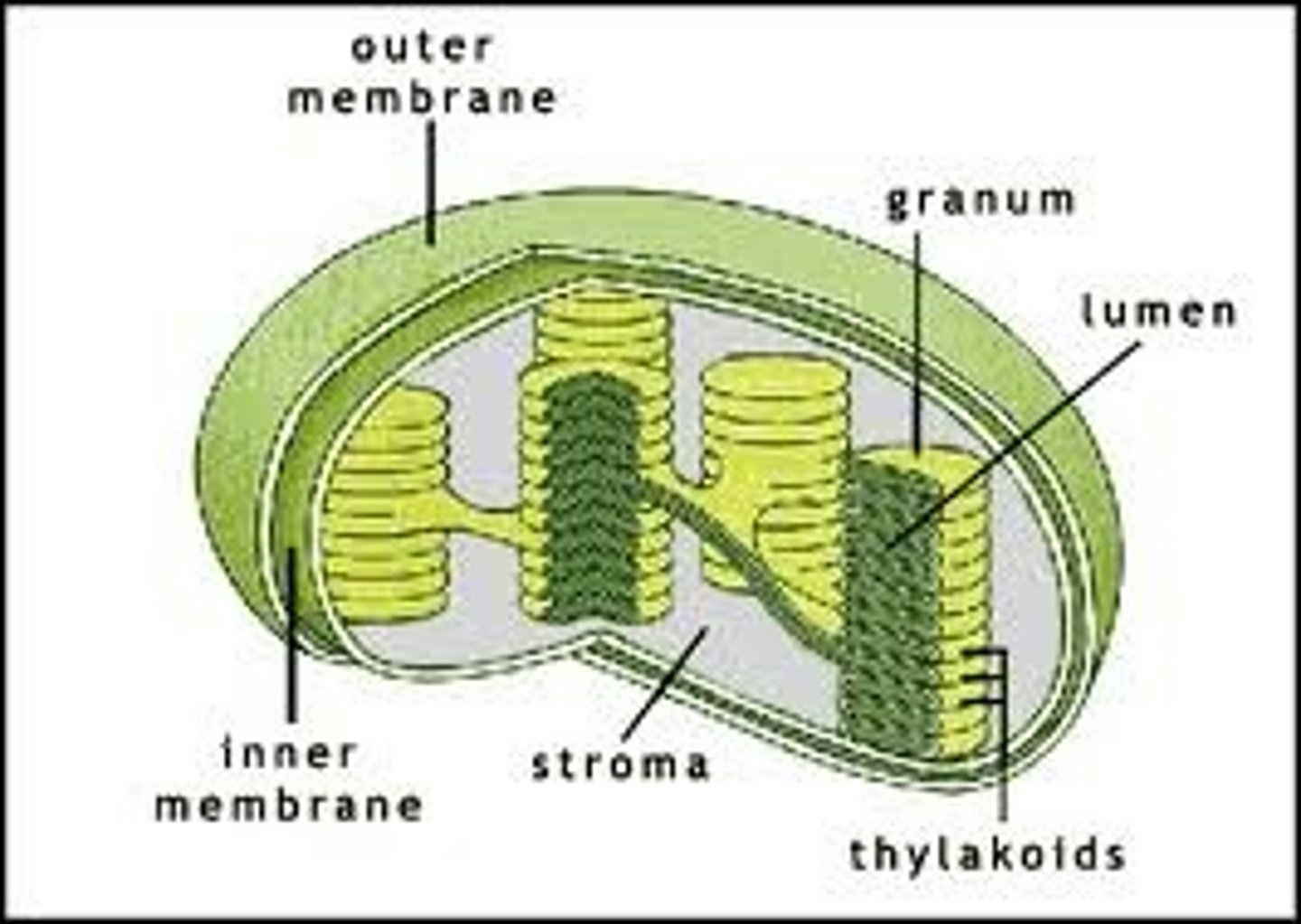
wavelength
Scientists can determine the amount of energy of a wave by measuring its ______ (the shorter, the more powerful)
electromagnetic spectrum
the range of all possible frequencies of radiation
electromagnetic radiation originating from the sun
X-rays and ultraviolet (UV) rays.
photosystem
The actual step that converts light energy into chemical energy takes place in a multiprotein complex called a
light-harvesting complex
A complex of proteins associated with pigment molecules (including chlorophyll a, chlorophyll b, and carotenoids) that captures light energy and transfers it to reaction-center pigments in a photosystem. It passes energy from sunlight to the reaction center; it consists of multiple antenna pigments that contain a mixture of 300 to 400 chlorophyll a and b molecules as well as other pigments like carotenoids.
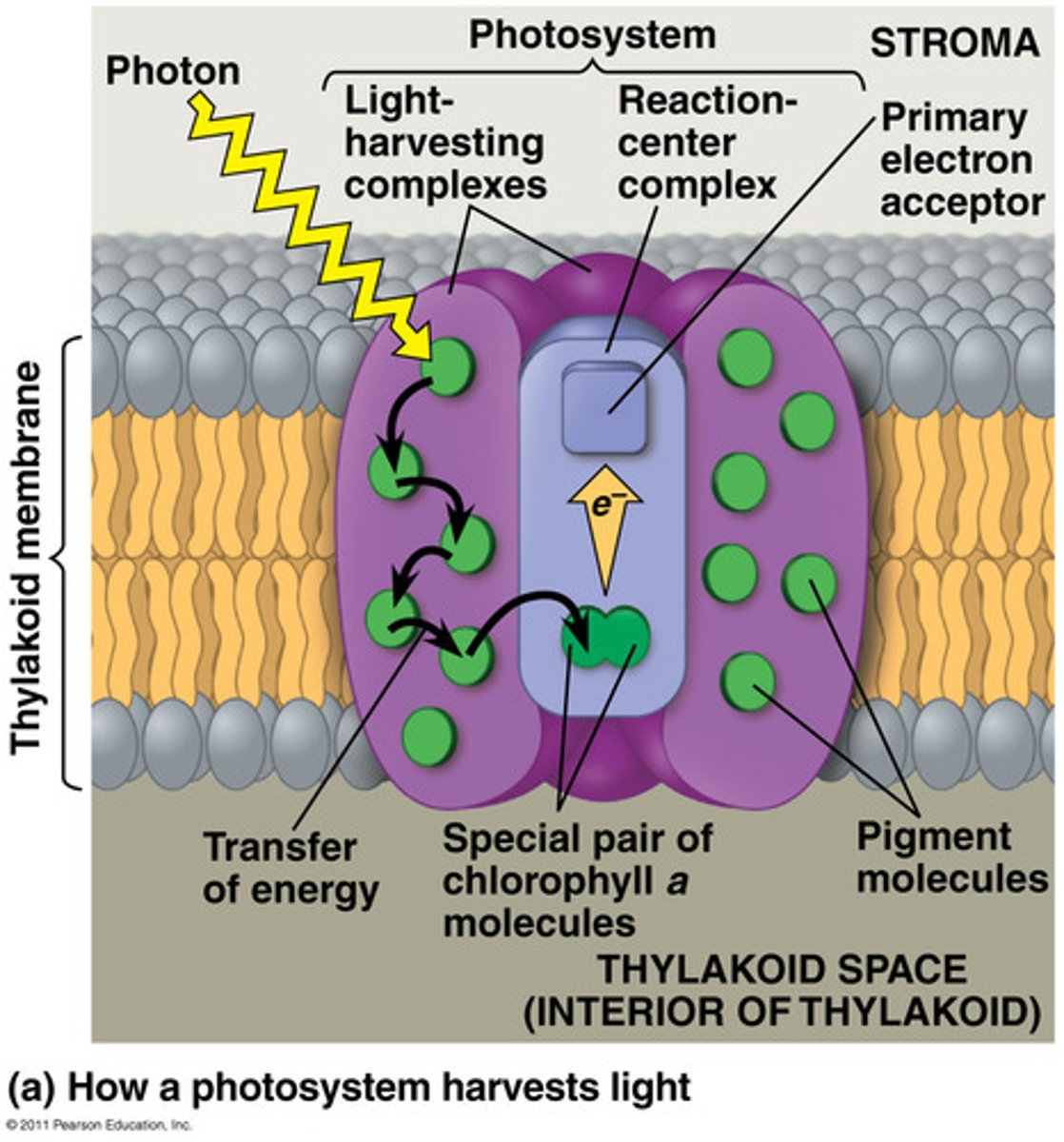
The passive diffusion of hydrogen ions from high concentration (in the thylakoid lumen) to low concentration (in the stroma) is harnessed to create
ATP. The ions build up energy because of diffusion and because they all have the same electrical charge, repelling each other.
Calvin cycle
reactions of photosynthesis in which energy from ATP and NADPH is used to build high-energy compounds such as sugars. Named after
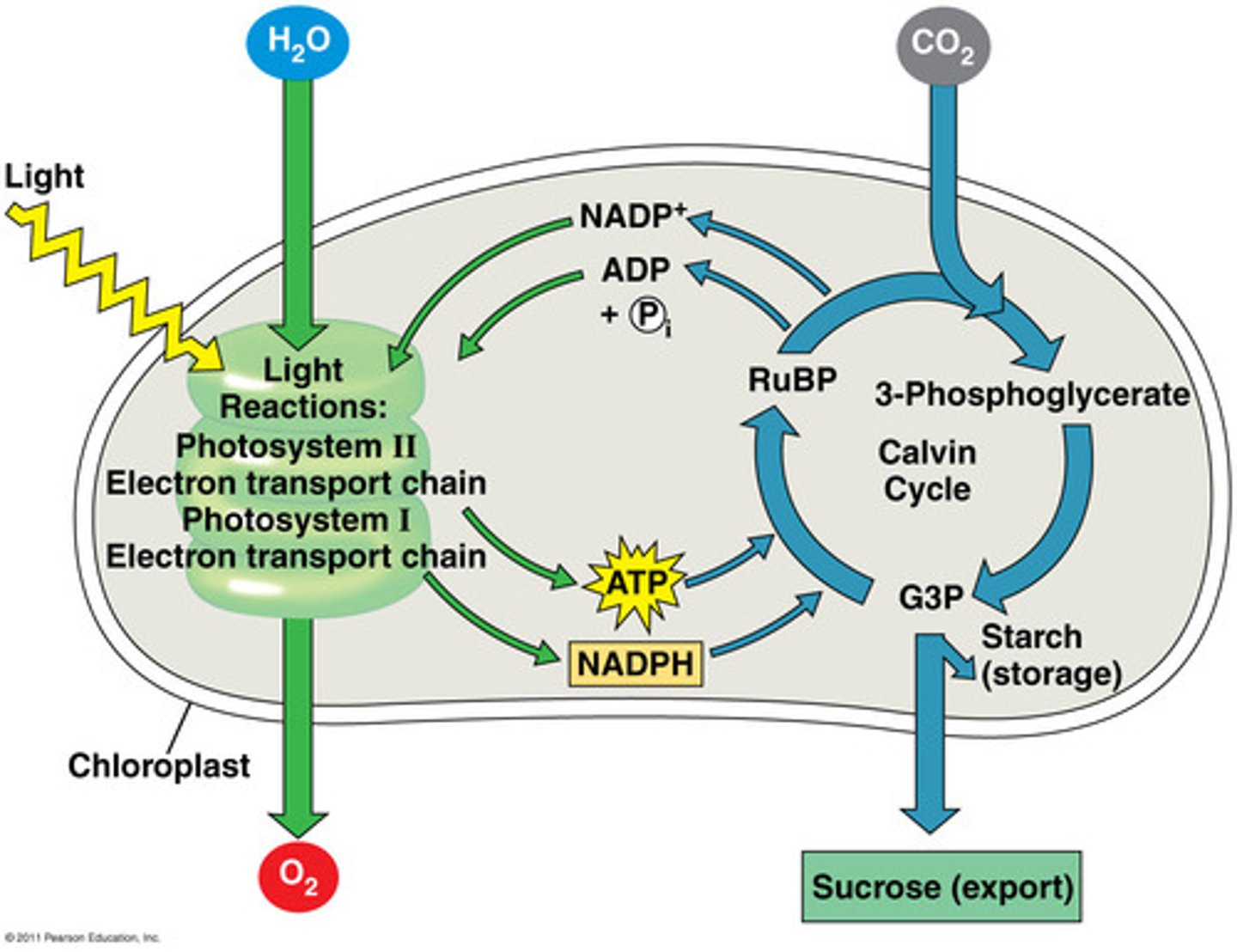
dark reaction
Calvin Cycle. Can be misleading because it implies incorrectly that the reaction only occurs at night or is independent of light, which is why most scientists and instructors no longer use it.
Stages of the Calvin Cycle
1. Fixation of CO2
2. Reduction of CO2
3. Regeneration of RuBP
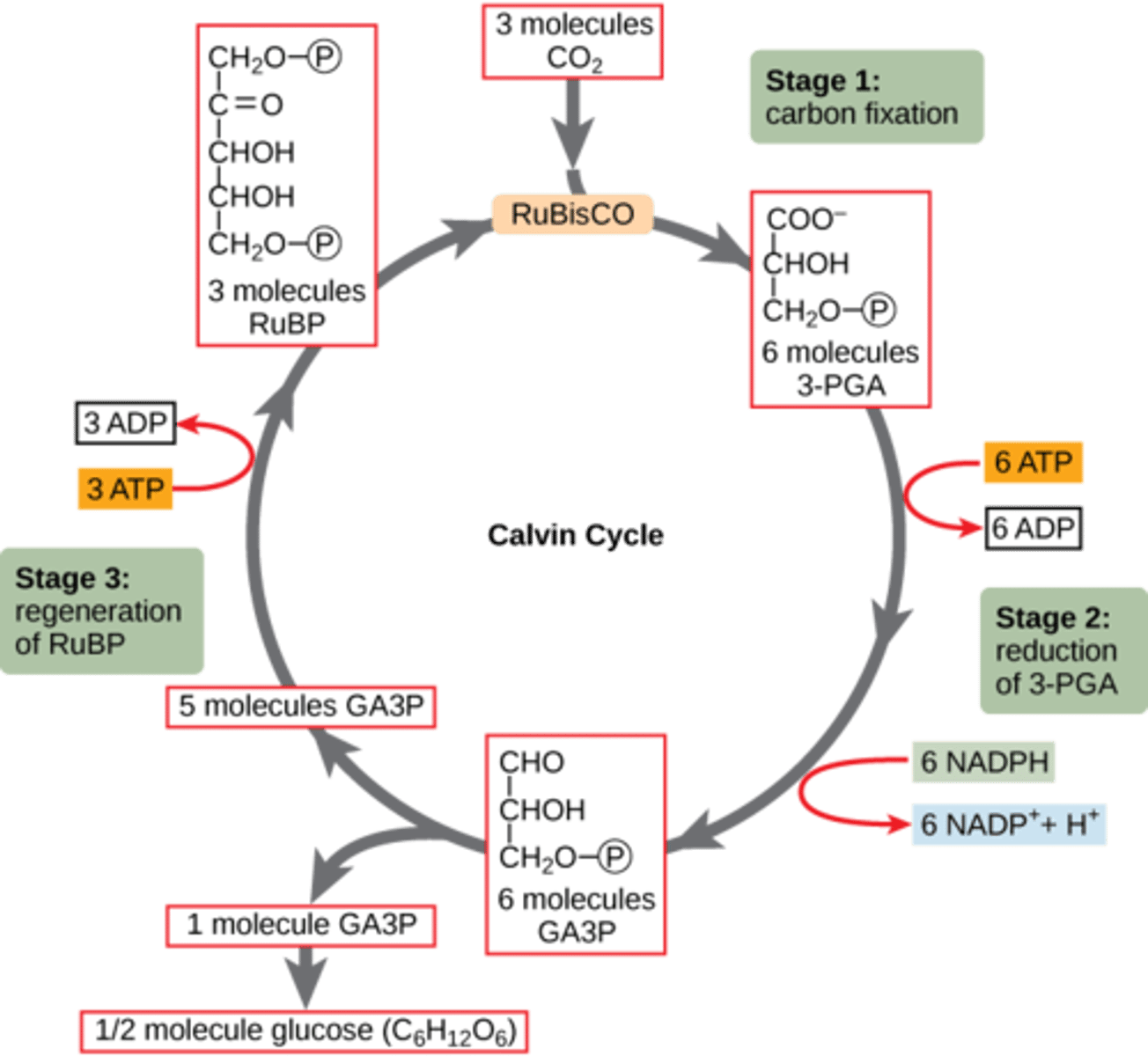
Calvin cycle stage 1: fixation
In the stroma, in addition to CO2, two other components are present to initiate the light-independent reactions: an enzyme called ribulose-1,5-bisphosphate carboxylase/oxygenase (RuBisCO), and three molecules of ribulose bisphosphate (RuBP). RuBP has five atoms of carbon, flanked by two phosphates.
heterotrophs
An organism that obtains organic food molecules by eating other organisms or their by-products. ("Other feeders")
chemoautotrophs
synthesize sugars, not by using sunlight's energy, but by extracting energy from inorganic chemical compounds.
stomata
The gas exchange of carbon dioxide and oxygen occurs through small, regulated openings called
thylakoid lumen
aqueous space bound by a thylakoid membrane where protons accumulate during light-driven electron transport
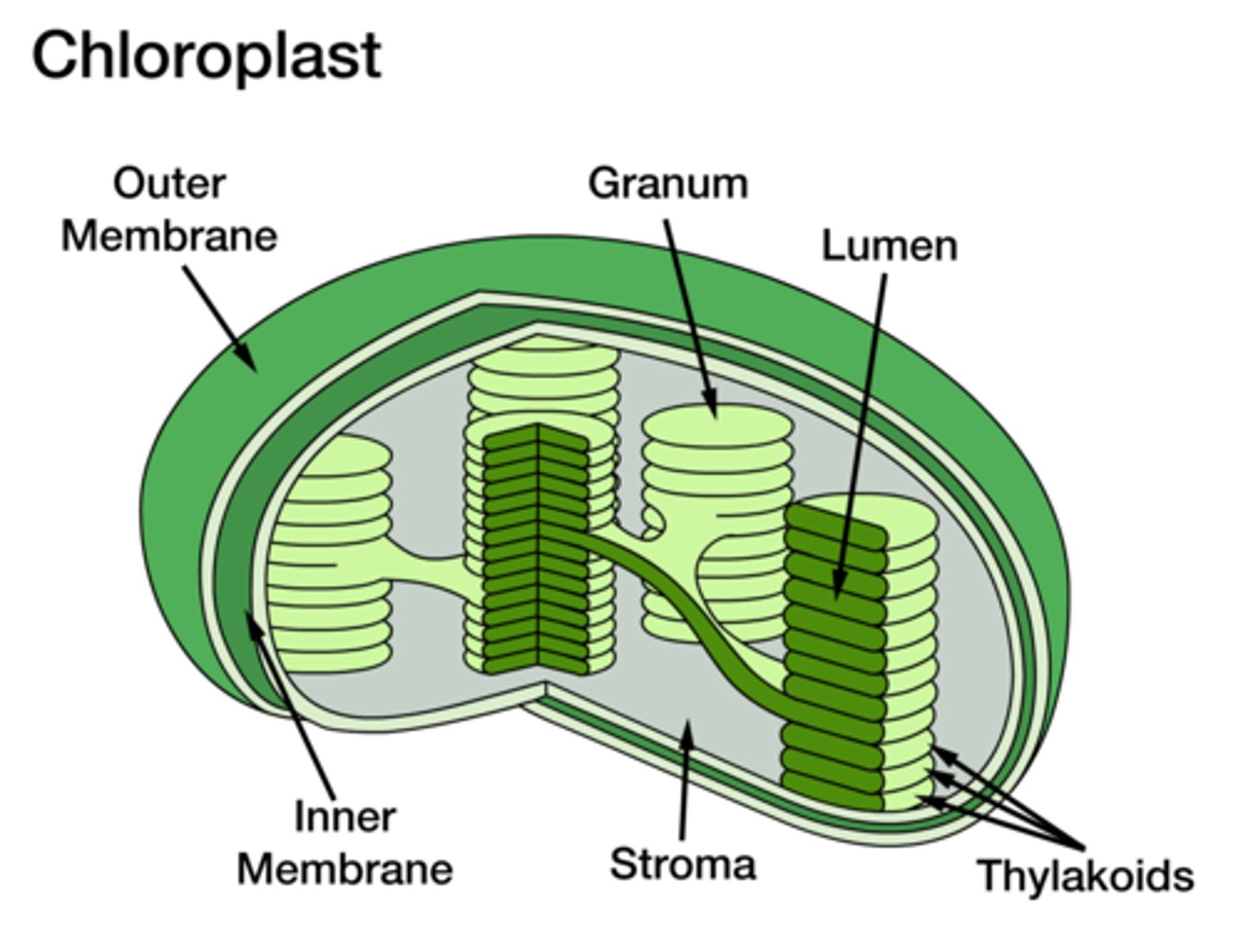
light-dependent reactions
reactions of photosynthesis that use energy from light to produce ATP and NADPH
light-independent reactions
set of reactions in photosynthesis that do not require light; energy from ATP and NADPH is used to build high-energy compounds such as sugar; also called the Calvin cycle
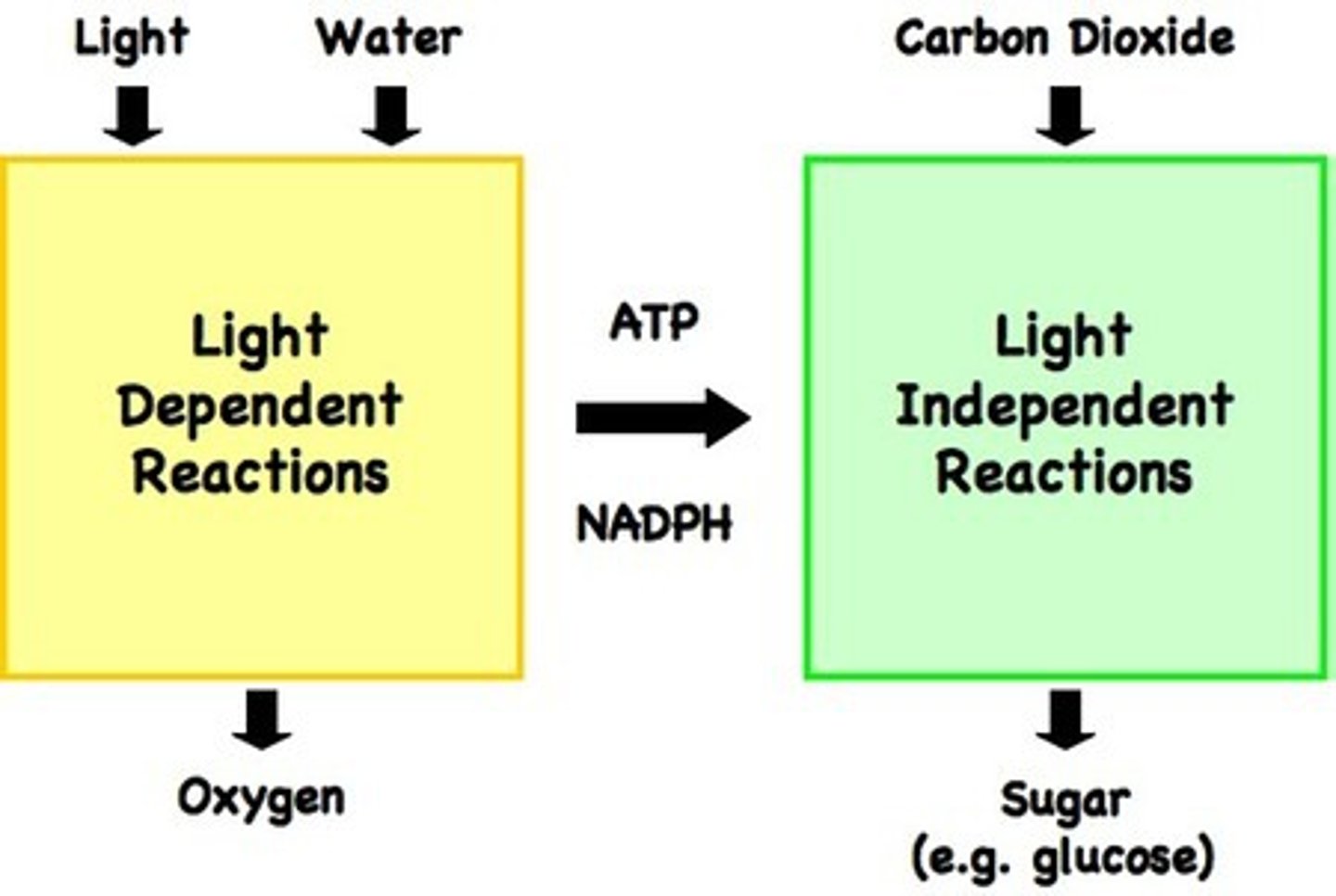
Light energy initiates the process of photosynthesis when pigments
absorb specific wavelengths of visible light.
Energy levels lower than those represented by red light are insufficient to
raise an orbital electron to an excited (quantum) state.
Energy levels higher than those in blue light will
physically tear the molecules apart, in a process called bleaching.
Our retinal pigments can only "see" (absorb) wavelengths between
700 nm and 400 nm of light, a spectrum that is therefore called visible light. For the same reasons, plants, pigment molecules absorb only light in the wavelength range of 700 nm to 400 nm; plant physiologists refer to this range for plants as photosynthetically active radiation.
Chlorophyll a
A photosynthetic pigment that participates directly in the light reactions, which convert solar energy to chemical energy.
chlorophyll b
An accessory photosynthetic pigment that transfers energy to chlorophyll a.
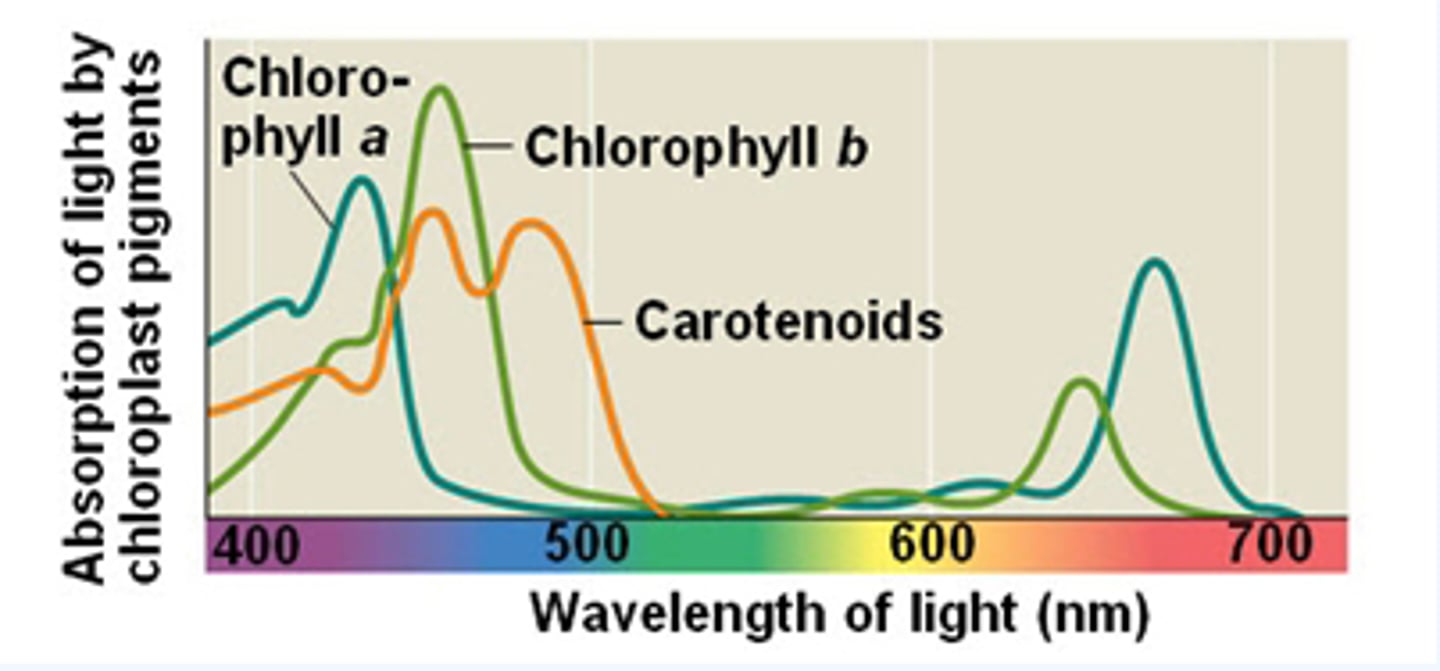
carotenoids
function as photosynthetic pigments that are very efficient molecules for the disposal of excess energy.
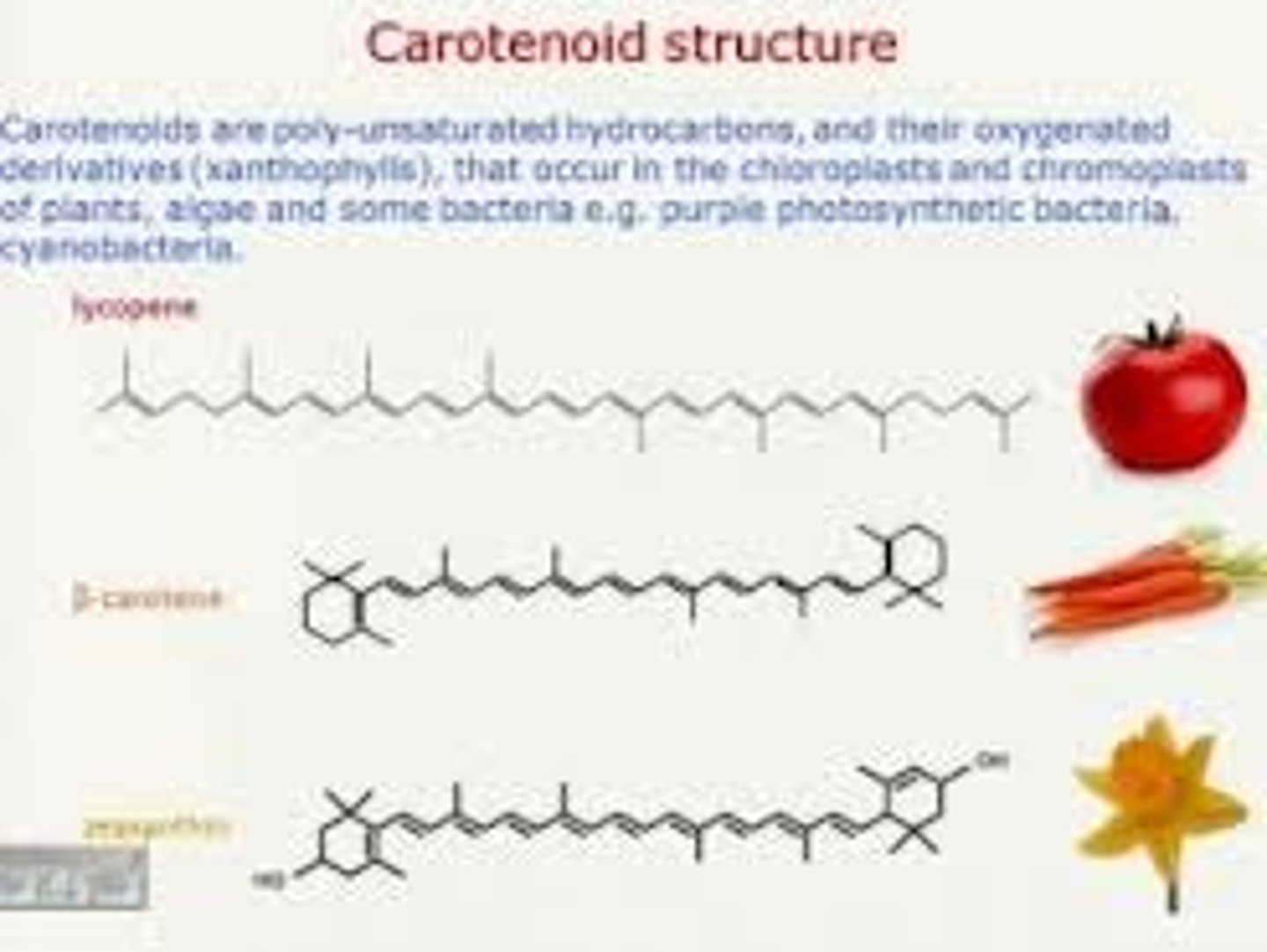
absorption spectrum
Each type of pigment can be identified by the specific pattern of wavelengths it absorbs from visible light: This is termed the
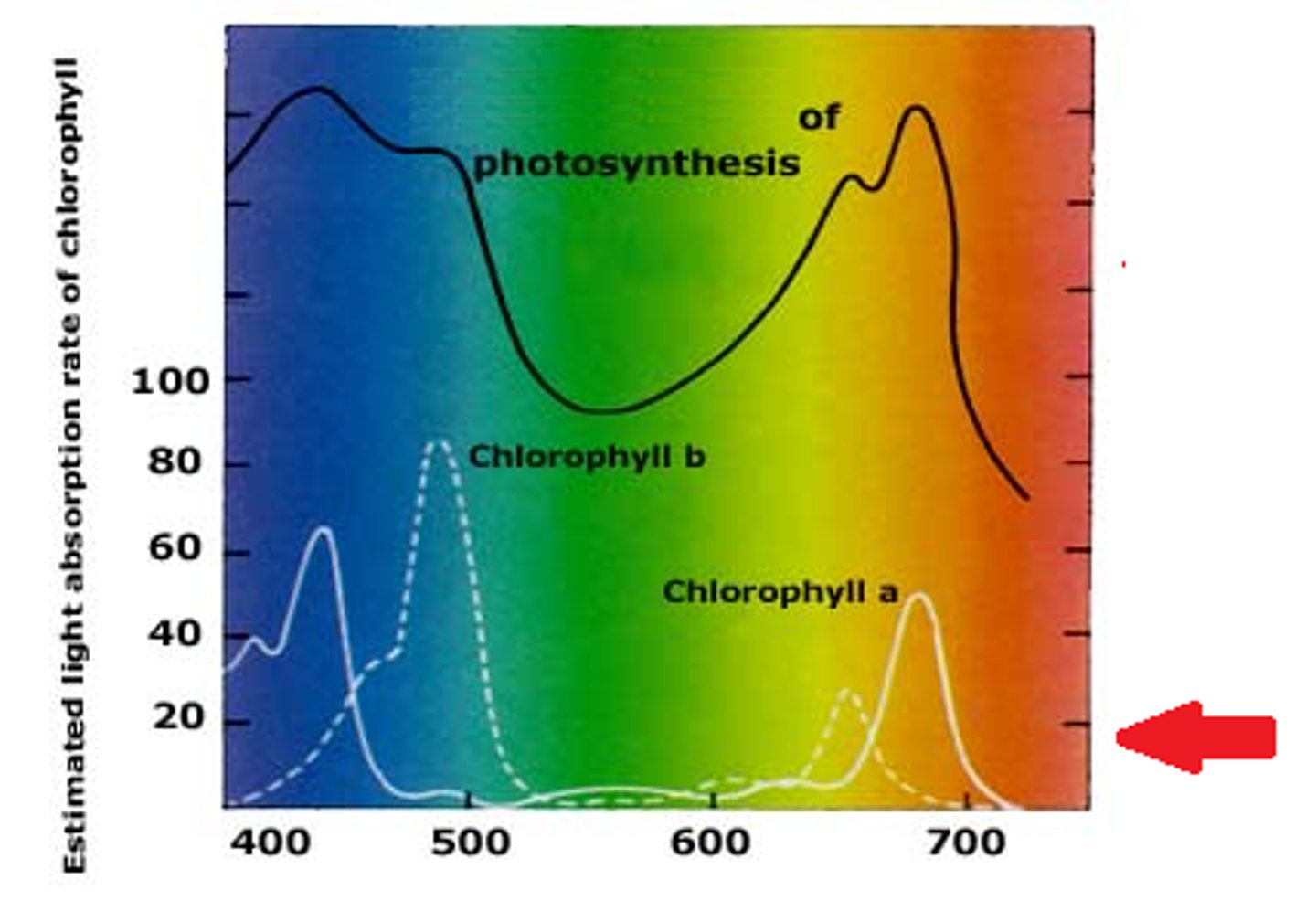
Carotenoids absorb in
the short-wavelength blue region, and reflect the longer yellow, red, and orange wavelengths.
spectrophotometer
An instrument that measures the proportions of light of different wavelengths absorbed and transmitted by a pigment solution.
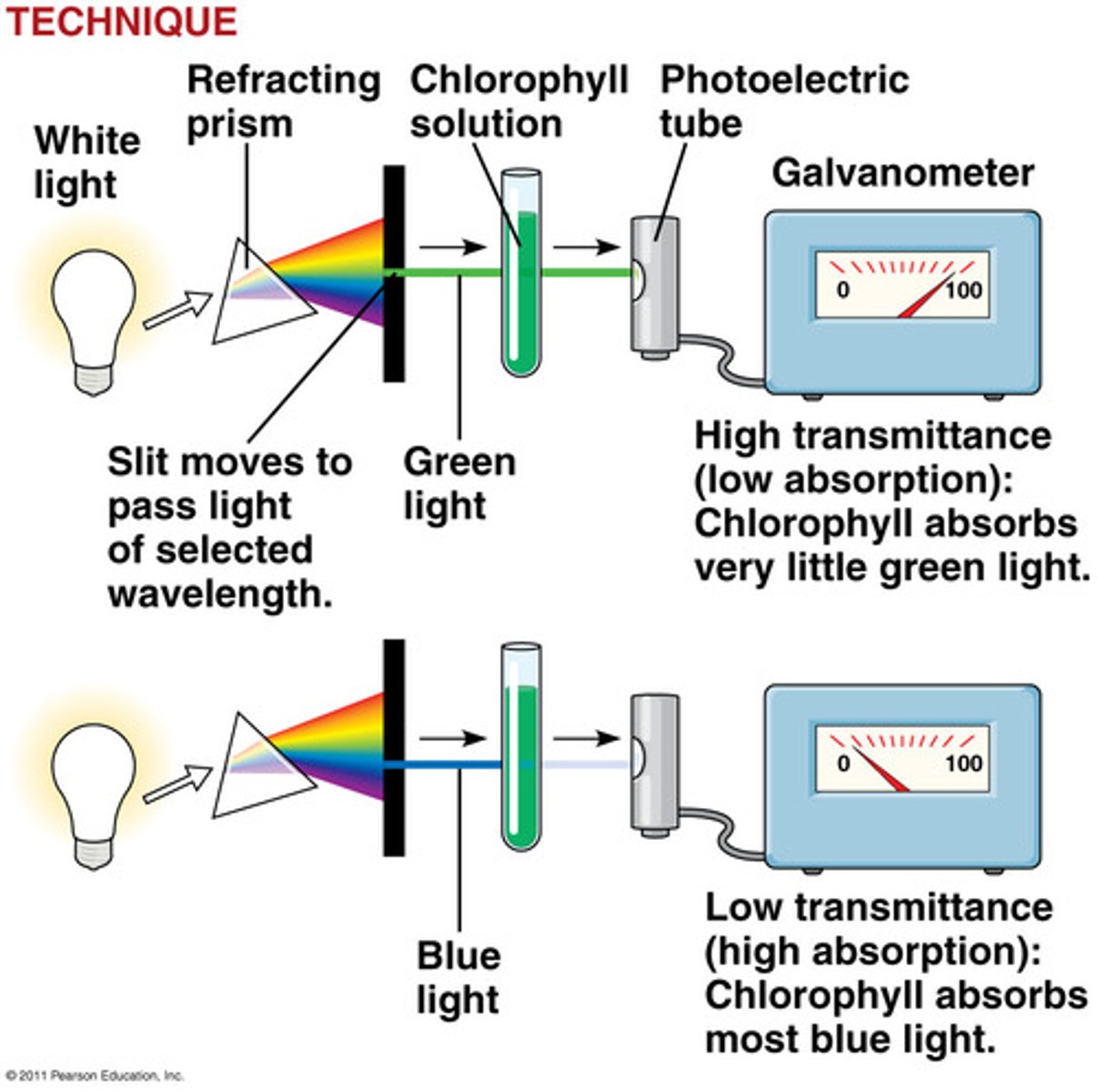
How Light-Dependent Reactions Work
The overall function of light-dependent reactions is to convert solar energy into chemical energy in the form of NADPH and ATP. This chemical energy supports the light-independent reactions and fuels the assembly of sugar molecules. Protein complexes and pigment molecules work together to produce NADPH and ATP. The numbering of the photosystems is derived from the order in which they were discovered, not in the order of the transfer of electrons.
photosystem II
One of two light-harvesting units of a chloroplast's thylakoid membrane; it uses the P680 reaction-center chlorophyll.
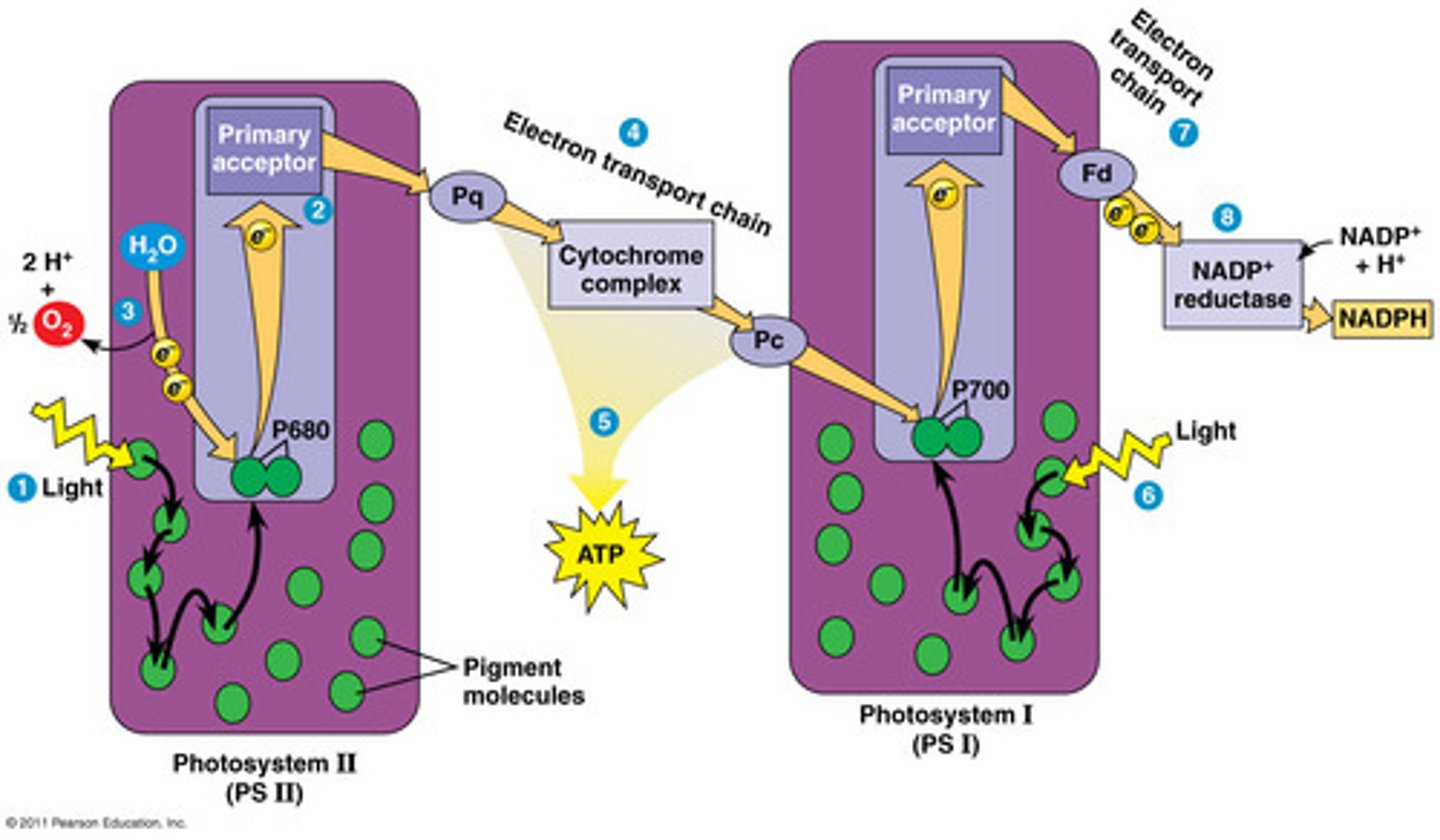
reaction center
Complex of proteins associated with two special chlorophyll a molecules and a primary electron acceptor. Located centrally in a photosystem, this complex triggers the light reactions of photosynthesis. Excited by light energy, one of the chlorophylls donates an electron to the primary electron acceptor, which passes an electron to an electron transport chain.
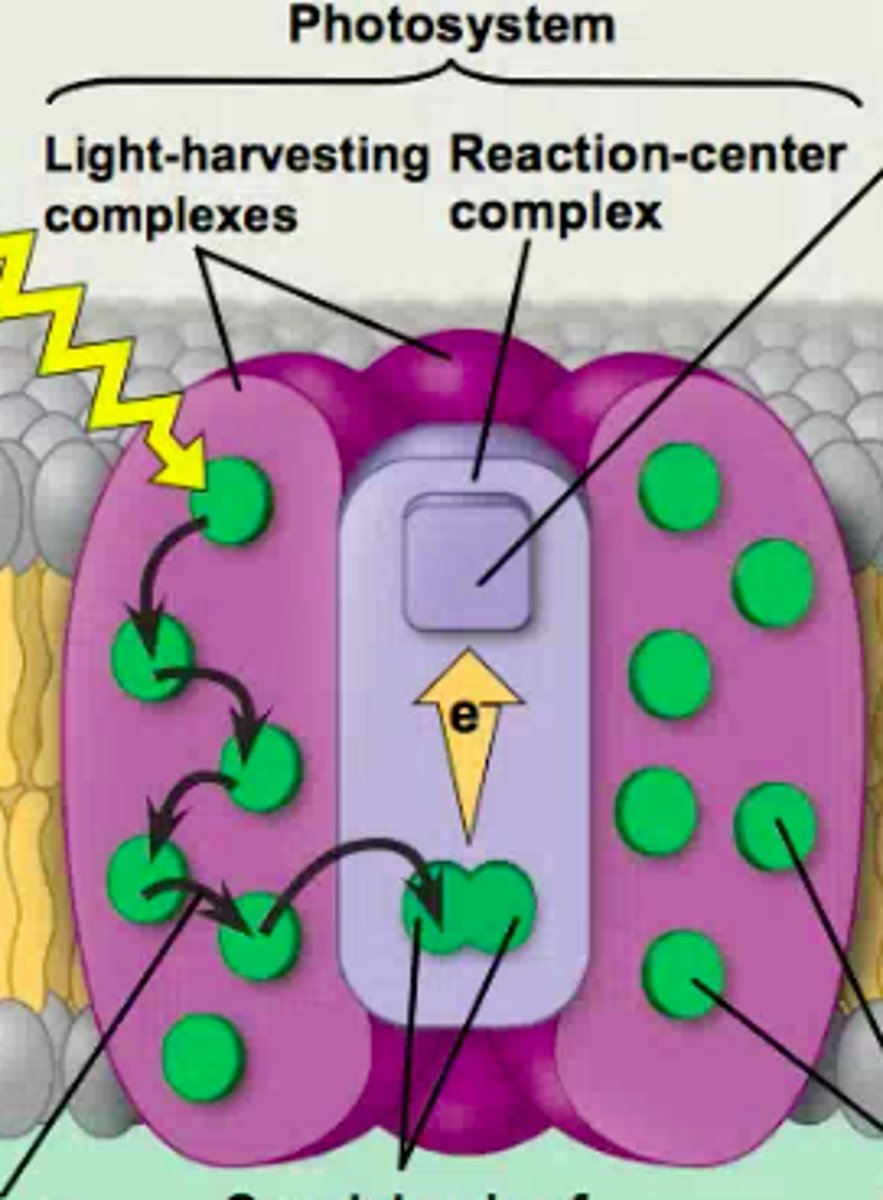
The absorption of a single photon or distinct quantity or "packet" of light by any of the chlorophylls pushes that molecule into
an excited state
photoact
ejection of an electron from a reaction center using the energy of an absorbed photon
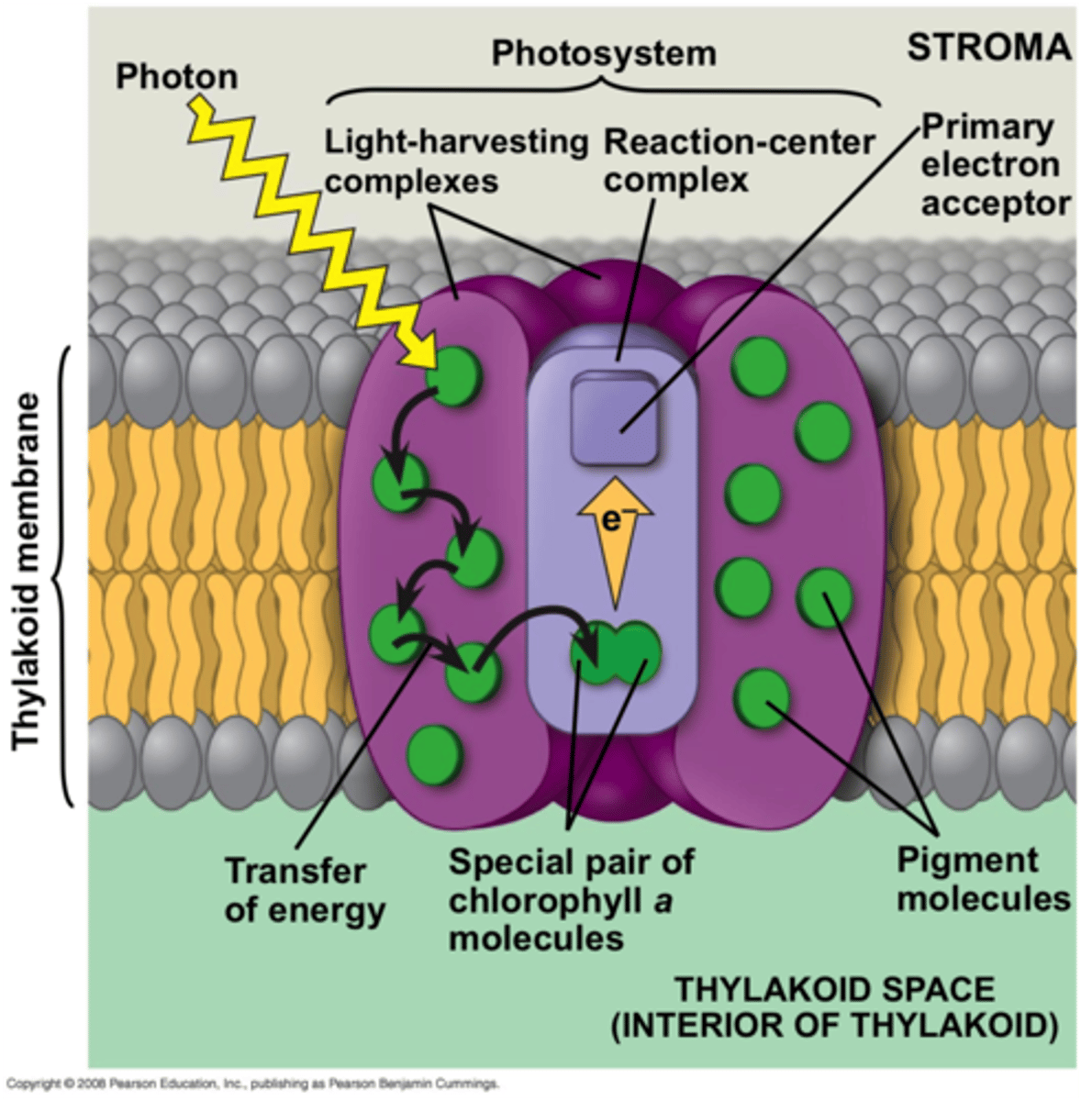
electron transport chain
A sequence of electron carrier molecules (membrane proteins) that shuttle electrons during the redox reactions that release energy used to make ATP.
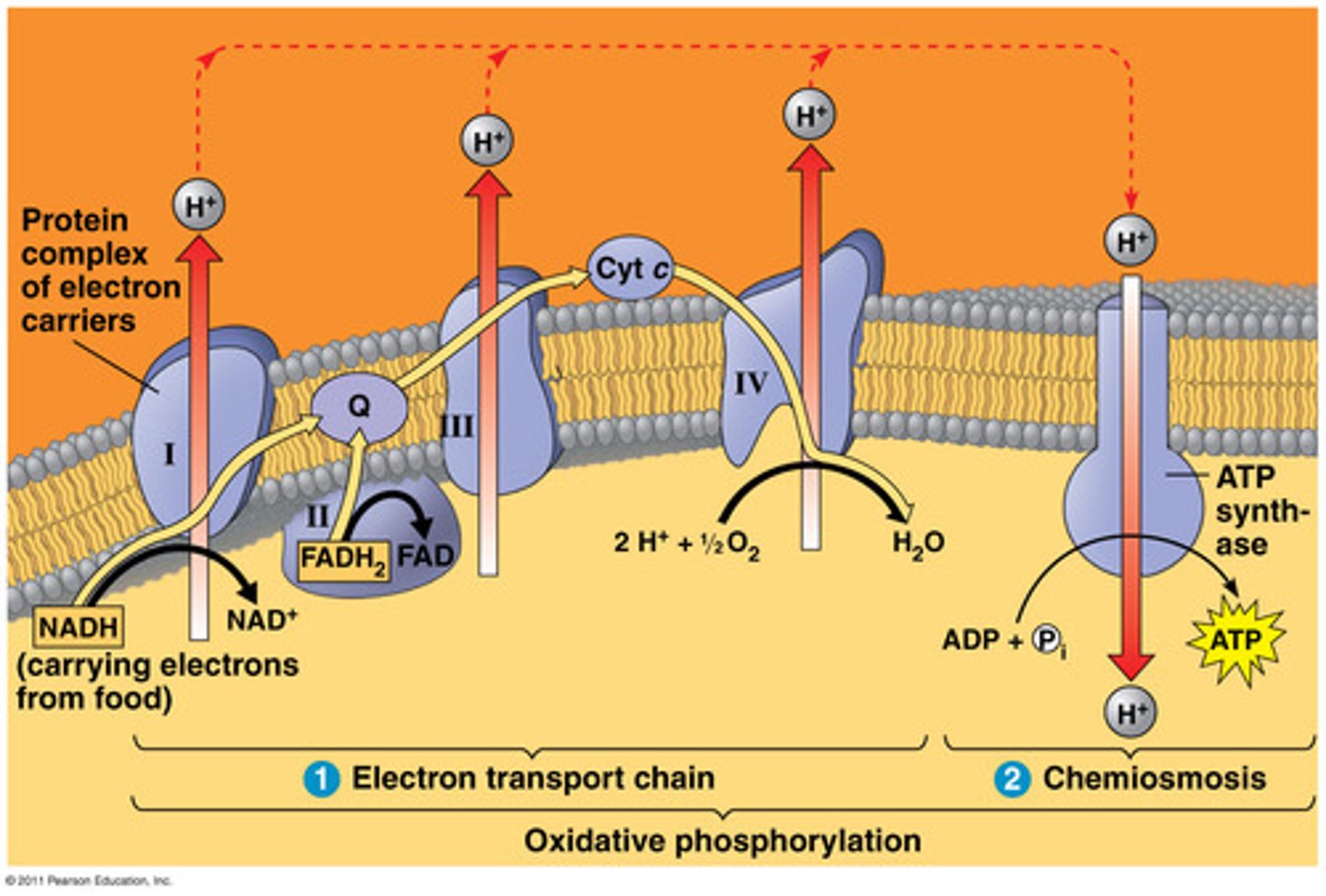
The reaction center of PSII (called P680)
delivers its high-energy electrons, one at the time, to the primary electron acceptor, and through the electron transport chain (Pq to cytochrome complex to plastocyanine) to PSI. P680's missing electron is replaced by extracting a low-energy electron from water; thus, water is "split" during this stage of photosynthesis, and PSII is re-reduced after every photoact. Splitting one H2O molecule releases two electrons, two hydrogen atoms, and one atom of oxygen. However, splitting two molecules is required to form one molecule of diatomic O2 gas. About 10 percent of the oxygen is used by mitochondria in the leaf to support oxidative phosphorylation. The remainder escapes to the atmosphere where it is used by aerobic organisms to support respiration.
What happens to electrons as they move through the proteins between PSII and PSI?
They lose energy.
Where do hydrogen atoms move during the electron transport chain in photosynthesis?
From the stromal side of the membrane to the thylakoid lumen.
What is the role of PSI in photosynthesis?
To re-energize electrons and send a high-energy electron to NADP+ to form NADPH.
How do PSII and PSI work together to produce ATP and NADPH?
PSII creates proton gradients to make ATP, while PSI reduces NADP+ into NADPH.
Why do the two photosystems in photosynthesis need to work in concert?
To ensure that the production of NADPH roughly equals the production of ATP.
concentration gradient
As in the intermembrane space of the mitochondria during cellular respiration, the buildup of hydrogen ions inside the thylakoid lumen creates a
chemiosmosis
The flow of hydrogen ions through ATP synthase is called ______ because the ions move from an area of high to an area of low concentration through a semi-permeable structure of the thylakoid.
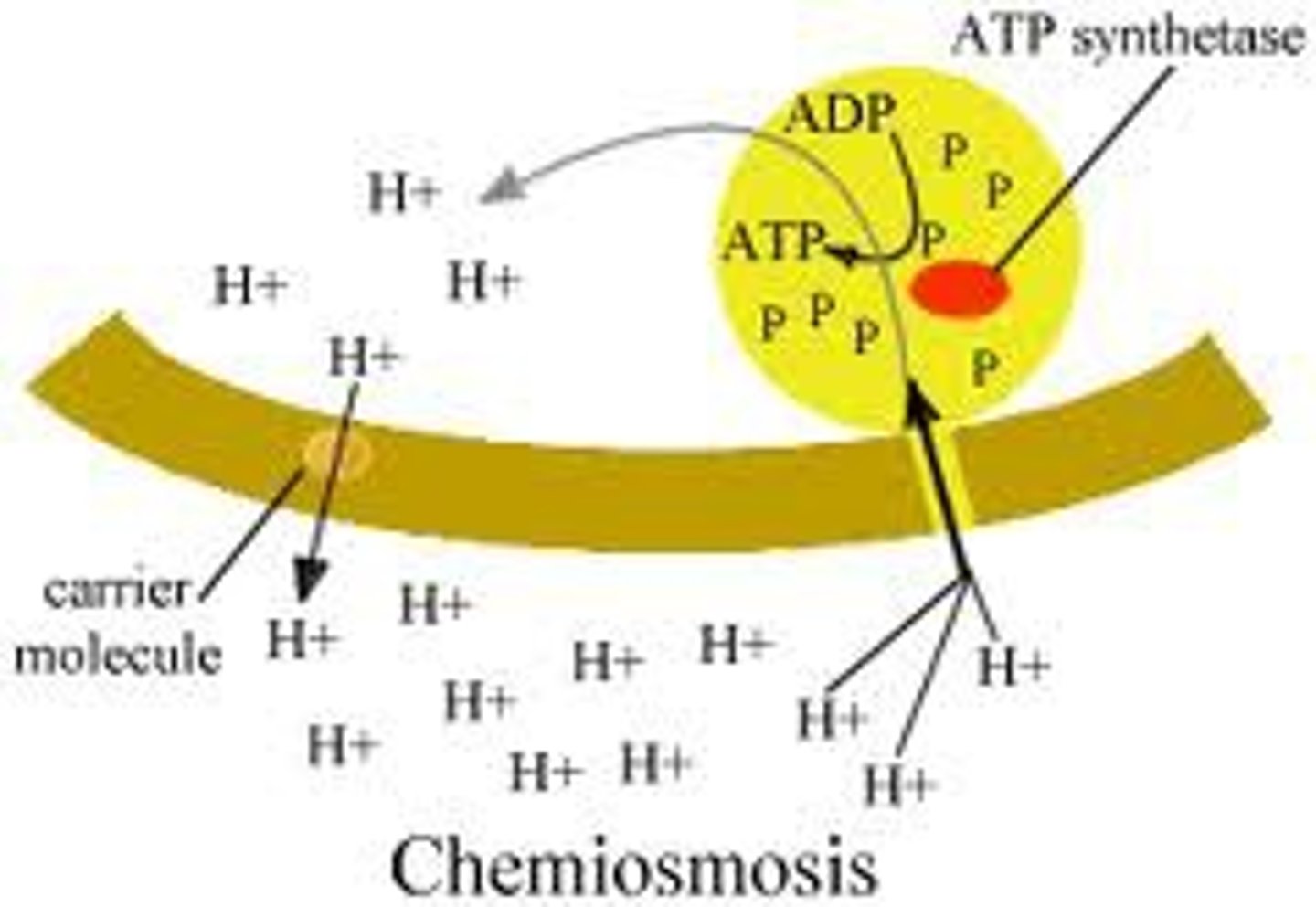
carbon fixation
The incorporation of carbon from carbon dioxide into an organic compound by an autotrophic organism.
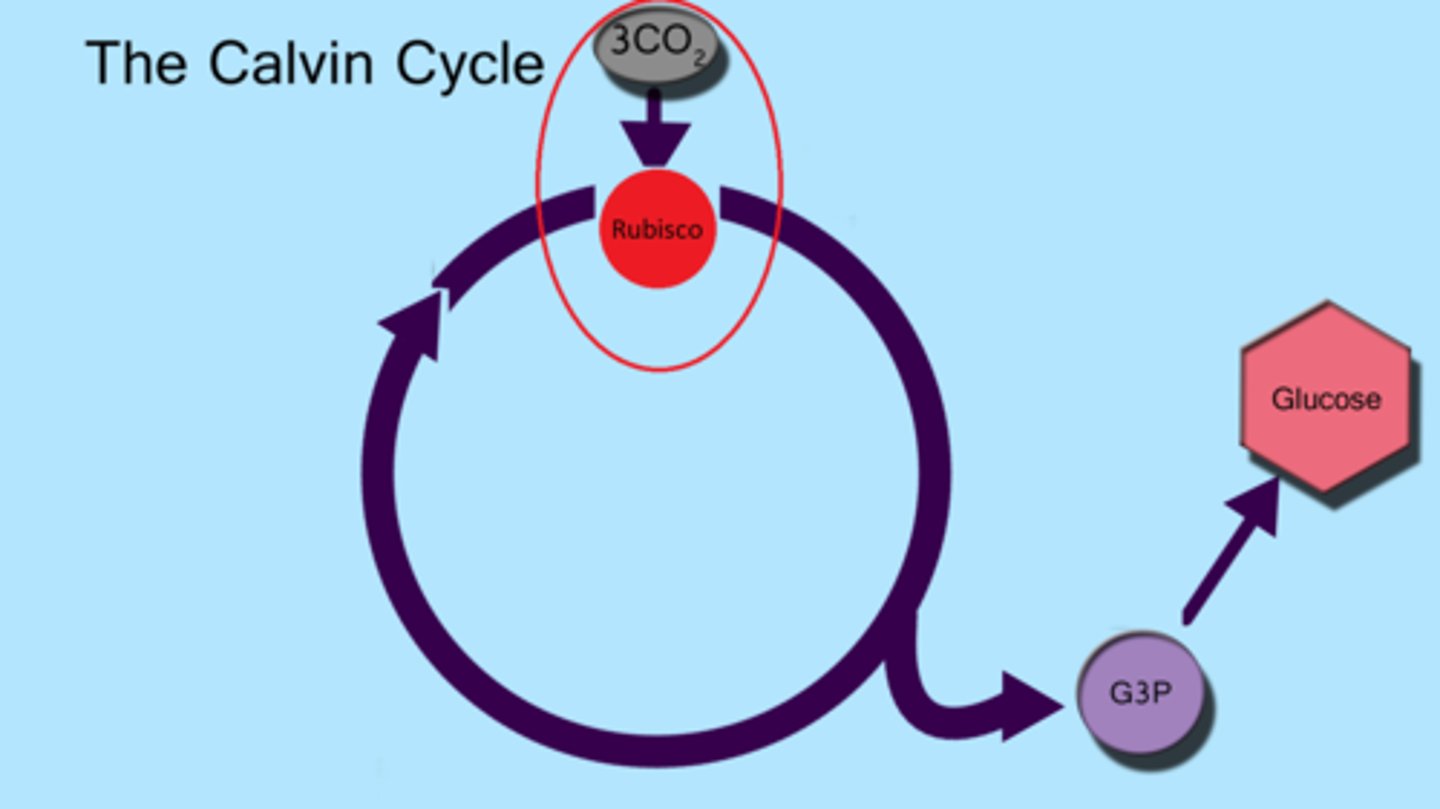
Calvin cycle Stage 2: Reduction
ATP and NADPH are used to convert the six molecules of 3-PGA into six molecules of a chemical called glyceraldehyde 3-phosphate (G3P). That is a reduction reaction because it involves the gain of electrons by 3-PGA. (Recall that a reduction is the gain of an electron by an atom or molecule.) Six molecules of both ATP and NADPH are used. For ATP, energy is released with the loss of the terminal phosphate atom, converting it into ADP; for NADPH, both energy and a hydrogen atom are lost, converting it into NADP+. Both of these molecules return to the nearby light-dependent reactions to be reused and re-energized.
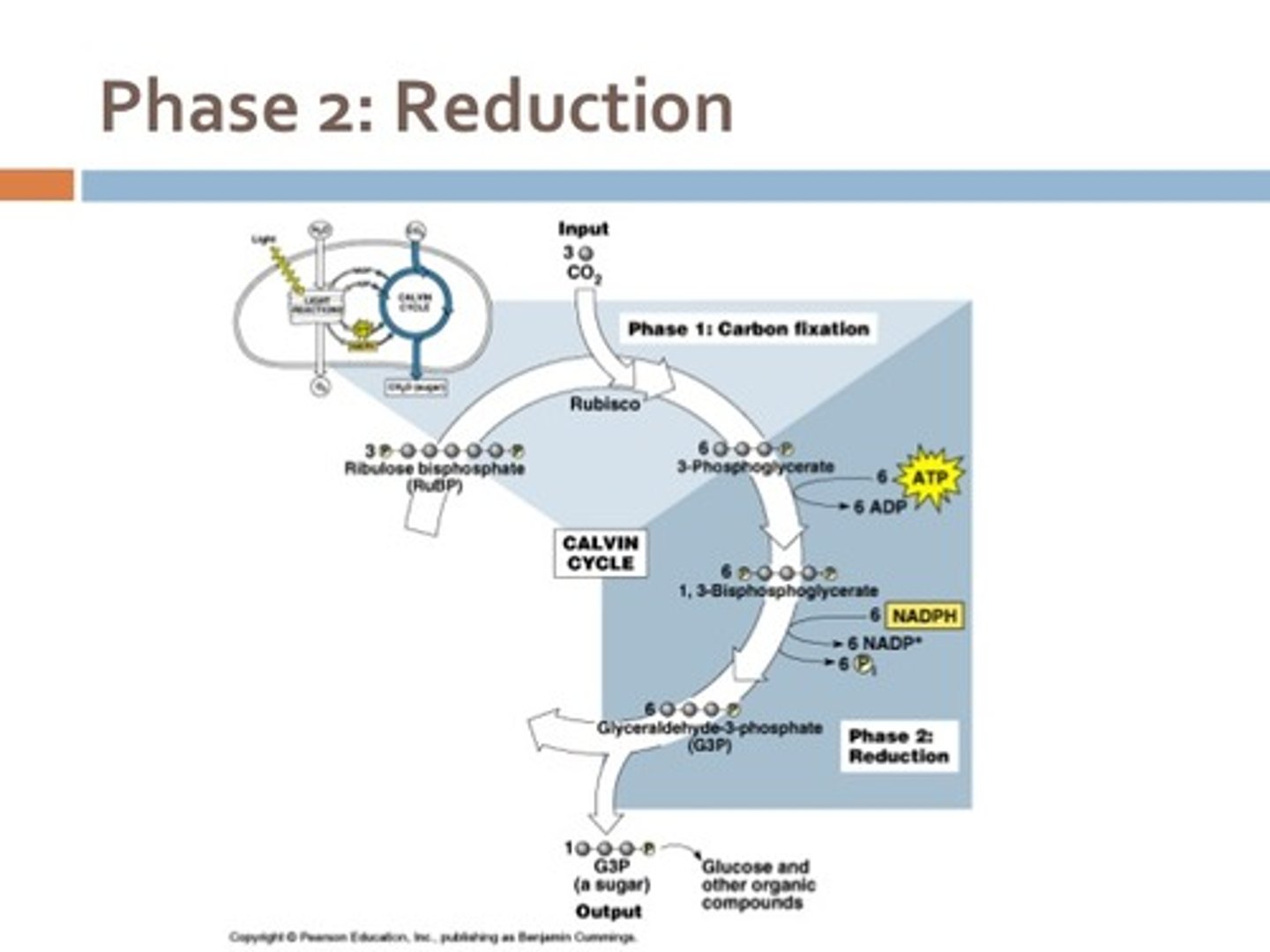
What happens to one of the G3P molecules in the Calvin cycle Stage 3: Regeneration?
It leaves the cycle and is sent to the cytoplasm to contribute to the formation of other compounds needed by the plant.
How many carbon atoms does the G3P molecule exported from the chloroplast have?
Three carbon atoms.
How many turns of the Calvin cycle are needed to fix enough net carbon to export one G3P?
Three turns.
What happens to the remaining five G3P molecules in the Calvin cycle Stage 3: Regeneration?
They are used to regenerate RuBP, preparing the system for more CO2 fixation.
How many molecules of ATP are used in the regeneration reactions of the Calvin cycle Stage 3: Regeneration?
Three molecules of ATP.
Energy from electrons passing through ETC is
used to pump protons from stroma into thylakoid space (lumen), forming a proton gradient across thylakoid membrane
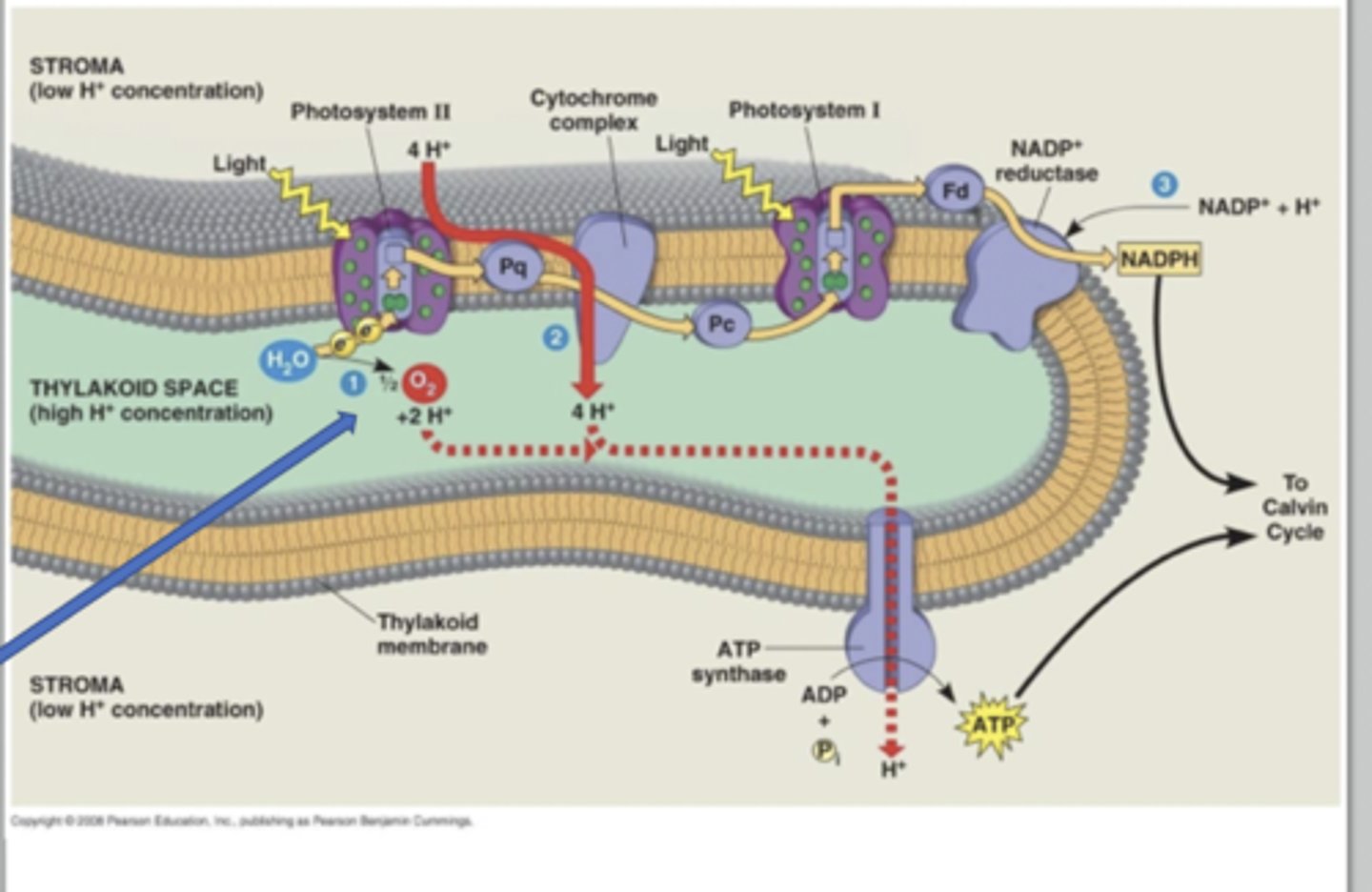
The Calvin Cycle Three stages
1. CO2 uptake/fixation: CO2 added to RuBP by enzyme Rubisco to generate2 3-PGA molecules
2. Reduction: ATP and NADPH used to add e- and make sugar (GA3P) Note 2 GA3P glucose
3. Regeneration: of RuBP from GA3P
rubisco
The most abundant protein on earth. Performs Carbon Fixation in the Calvin Cycle.
CO2 Uptake/Fixation
CO2 reacts with 5-carbon Ribulose Bisphosphate (RuBP)• Catalyzed by rubisco (ribulose bisphosphate carboxylase/oxygenase)•
The unstable 6-carbon product breaks down into two molecules of 3-carbonPGA (phosphoglycerate)•
The carbon of the CO2 molecule has been "fixed" to a carbon skeletonCO2 Uptake/Fixation
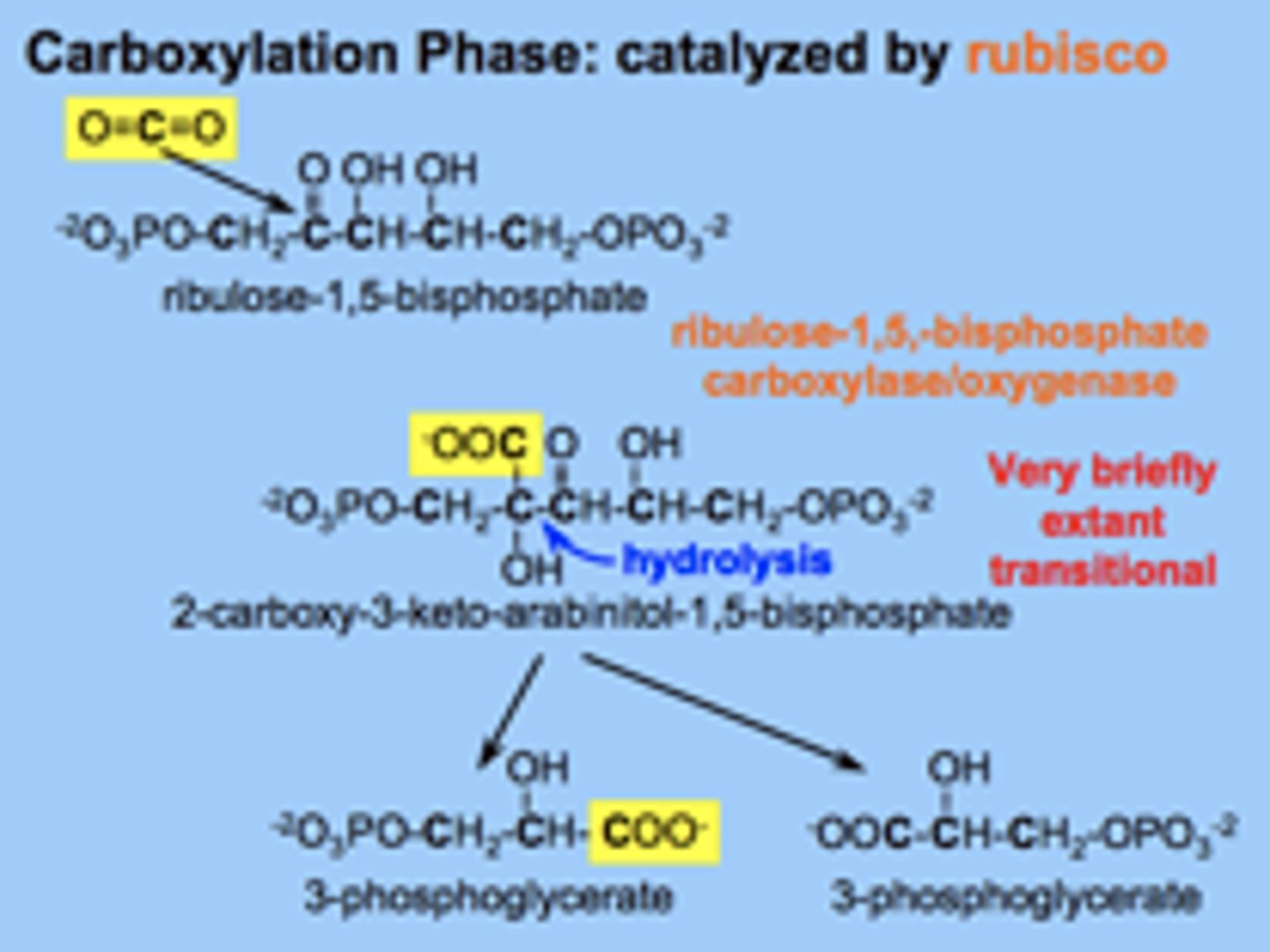
RuBP Regeneration
Ribulose phosphate is phosphorylated by ATP to produce RuBP, which is used to restart the cycle
Glycolysis two phases
energy investment phase and energy payoff phase
